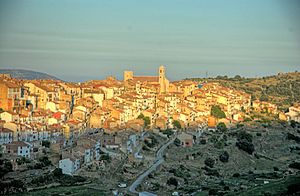Vilafranca facts for kids
Quick facts for kids
Vilafranca
|
||
|---|---|---|
| Villafranca del Cid | ||
 |
||
|
||
| Country | ||
| Autonomous community | ||
| Province | Castellón | |
| Comarca | Ports | |
| Judicial district | Castellón de la Plana | |
| Area | ||
| • Total | 93.8 km2 (36.2 sq mi) | |
| Elevation | 1,125 m (3,691 ft) | |
| Population
(2018)
|
||
| • Total | 2,227 | |
| • Density | 23.742/km2 (61.49/sq mi) | |
| Demonym(s) | Vilafranquí, Vilafranquina | |
| Time zone | UTC+1 (CET) | |
| • Summer (DST) | UTC+2 (CEST) | |
| Postal code |
12150
|
|
| Official language(s) | Valencian and Spanish | |
Vilafranca is a town in Spain. It is located in the Castellón province, within the Valencian Community. It is known as Villafranca del Cid in Spanish. Until 2022, it was part of a different region called l'Alt Maestrat.
Contents
Exploring Vilafranca's Geography
Vilafranca del Cid is in the western part of the Castellón province. It is about 95 km (59 mi) from the main city, Castellón. The town sits on a high flat area, about 1,125 meters (3,691 ft) above sea level.
Mountains and Valleys Around Vilafranca
Even though the town is high up, the land around it is very rough and hilly. Some of the highest points include:
- Tossal dels Montllats (1,643 m (5,390 ft))
- Tossal del Mas de Coder (1,467 m (4,813 ft))
- Tossal del Mas d'Altava (1,426 m (4,678 ft))
- Tossal del Mas de Tosca de Dalt (1,379 m (4,524 ft))
- Tossal d'Arriello (1,314 m (4,311 ft))
- Canto del Picaio (1,305 m (4,281 ft))
The lowest part of the area is near the Río Monleón river, at 710 m (2,330 ft) above sea level. These high points are mostly made of limestone. Over time, water has worn away the limestone, creating interesting shapes. This process also formed "Les Coves del Forcall," which are caves.
Getting to Vilafranca
You can reach Vilafranca from Castellón by taking the CV-10 and then the CV-15 roads.
Towns Near Vilafranca
Vilafranca del Cid shares borders with several other towns. These include:
All these towns are in the province of Castellón. Vilafranca also borders Mosqueruela and La Iglesuela del Cid, which are in the province of Teruel.
Vilafranca's Long History
The history of Vilafranca goes back a very long time, even before written records.
Early Beginnings and Roman Times
People lived here during the Bronze Age, as shown by the "Ereta Castellar" town site. Many Iberian sites are found around the area. There are also old rock paintings. Evidence of the Romans has been found too, like old roads and coins.
The modern town of Vilafranca officially started on February 7, 1239. Don Blasco de Alagon founded it. He first called it "Rivus Truitarum" or "Riu de les Truites," which means "River of the Trout." The Gothic-Roman bridge over the "Riu de les Truites" is famous because King Jaime I crossed it. This was when he first entered the land of Castellón.
Seeking Independence
Vilafranca first belonged to the Alagon family, then the Anglesola family, and then back to Alagon. On May 14, 1303, it became part of the larger area controlled by the Castillo de Morella (Morella Castle).
However, on December 27, 1333, the people of Vilafranca disagreed with decisions made by Morella. This started a fight for independence that lasted almost 400 years. Other villages joined this struggle.
There were also disagreements with Mosqueruela. Vilafranca lost control of Mallo castle and the village of Estrella between 1335 and 1340.
King Pedro IV of Aragon allowed Vilafranca to build walls and granted it independence from Morella on June 8, 1358. But eleven years later, he changed his mind and took away this special right.
Later, King Felipe IV understood that being controlled by Morella was a financial burden for the villages. To thank the villagers for their help in wars against France and Catalonia, he agreed to their independence.
Finally, on February 8, 1691, Joan Baptista Penyarroja, a notary for King Carlos II, helped all the villages, including Vilafranca, become independent royal towns.
Vilafranca in Wars
During the War of Spanish Succession, Vilafranca supported Archduke Charles of Austria.
Even though some people in Vilafranca supported traditional ways, the town generally sided with the liberals who supported Queen Elizabeth II. However, in 1834, Cabrera, a Carlist leader, surprised and took the town. Vilafranca then became a strong liberal area again. But it was later abandoned because it was caught between areas controlled by the Carlists during the Carlist Wars.
Two important battles were fought near Vilafranca:
- The Mas de la Carrasca
- The "Pla de Mosorro" battle on June 28, 1875.
In these battles, the forces of Jovellar, Azcarraga, and Villaviciosa won against Dorregaray, Cucala, and Villalaín (who died in action). This victory is seen as the beginning of the end of the war in central Spain and Valencia.
Modern Politics
In 1943, the provincial council chose Juan Antonio Aznar Inigo, who was the mayor of Vilafranca, to be a member of the Cortes Españolas (the Spanish parliament). He represented the municipalities of the province from 1943 to 1946.
See also
 In Spanish: Villafranca del Cid para niños
In Spanish: Villafranca del Cid para niños



